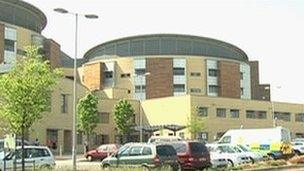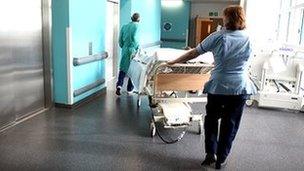Romford Queen's Hospital A&E: Patient cap to tackle 'poor care'
- Published

Inspectors made visits to Queen's Hospital's A&E department last year
The number of patients admitted to an east London hospital A&E unit is to be capped at busy times to improve care.
The Care Quality Commission (CQC) said the A&E department at Queen's Hospital, Romford, was providing patients with "unacceptably poor care".
It comes after inspectors found some A&E patients had to wait up to 11 hours before being transferred to a ward.
Barking, Havering and Redbridge University Hospitals NHS Trust said it was working to improve emergency care.
Check on improvements
Apologising to anyone who may have experienced poor care, trust chief executive Averil Dongworth said: "Improving performance in our emergency departments is the biggest challenge that we face, and is the area that is receiving the most attention from all parts of the organisation."
Inspectors made unannounced visits to the hospital in November and December having identified major concerns about the care and welfare of patients in March 2012.
Their report said: "We carried out this inspection to ensure they had made improvements, in relation to concerns identified about meeting waiting times and delays experienced by patients in receiving care and the quality of the care they received."
It said they found people using the "Majors" area who required admission were waiting far too long to be transferred to other parts of the hospital - 5% waited more than 11 hours.
The report said the trust should be aiming to transfer 95% of patients who are being admitted to wards within four hours of arrival.
During the inspections people were being nursed on trolleys when they needed to be moved into beds, increasing the risk of pressure sores, dehydration and falls.
The "Majors" area did not have any washing facilities or storage for personal possessions, and did not offer people the privacy and dignity they are entitled to, the report said.
Protection measure
Elsewhere in the department, personal information, including diagnosis, was displayed where anyone, including other members of the public, could see it.
There were not enough consultant or junior doctors in A&E.

The report said 95% of patients being admitted to wards should be transferred within four hours
Matthew Trainer, deputy director of CQC in London, said: "No-one should wait 11 hours' plus to be transferred to a bed, but some of the people we saw during our unannounced inspection had done just that.
"The area in which they were waiting was not set up to deliver good quality care to the standard CQC expects."
He said it now planned to place a legal restriction on the number of people who can be admitted to the "Majors" part of A&E if people already there have been waiting for too long.
"This is designed to protect people from the risk of harm, and to give the trust breathing space to make the changes it needs to make," he said.
Another unannounced inspection found required standards in maternity services at the hospital were now being met.
Ms Dongworth said while the CQC report noted Queen's A&E department was designed to deal with 90,000 attendances a year, they were now seeing about 132,000 people.
"It also confirms that Queen's receives more blue light ambulances than any other hospital in London, " she added.
She said: "Dealing with this volume of patients is hugely challenging and requires a joined-up approach to ensure that the trust is supported by services in the community."
The CQC is due to meet the Trust Development Authority and local commissioners next week to discuss next steps.
- Published29 January 2013
- Published26 January 2013
- Published11 January 2013
- Published27 June 2012
- Published27 October 2011
- Published27 February 2011
- Published27 January 2011